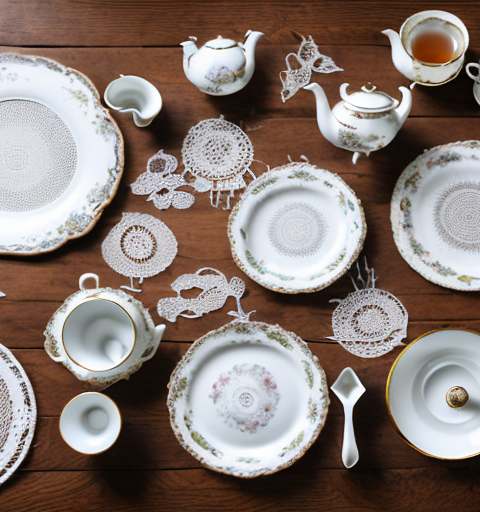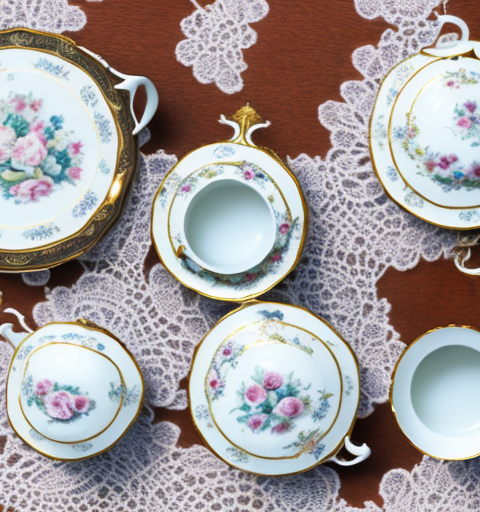Tea stains can be a common problem on the handle of a ceramic teapot. Over time, these stains can build up and make the handle look unattractive. However, with regular cleaning and proper maintenance, you can keep your ceramic teapot handle looking pristine. In this article, we will explore various methods and tips for effectively removing tea stains from ceramic teapot handles.
Understanding the cause of tea stains on ceramic teapot handles
Tea stains on ceramic teapot handles are caused by the tannins in tea, which can leave behind a residue after repeated use. These tannins can penetrate the porous surface of the ceramic, making the stains difficult to remove. Additionally, factors such as the type of tea used, the temperature of the water, and the length of time the tea is steeped can also contribute to the severity of the stains.
One factor that can contribute to the severity of tea stains on ceramic teapot handles is the type of tea used. Different types of tea contain varying levels of tannins, which can affect the intensity of the stains. For example, black tea tends to have higher tannin content compared to green or herbal teas, resulting in darker and more stubborn stains.
Furthermore, the temperature of the water used to brew the tea can also impact the formation of stains. Hotter water can cause the tannins to release more easily from the tea leaves, increasing the likelihood of staining. Similarly, longer steeping times can lead to stronger stains as the tannins have more time to interact with the ceramic surface.
The importance of regular cleaning and maintenance for ceramic teapot handles
Regular cleaning and maintenance are key in preventing and removing tea stains from ceramic teapot handles. By properly cleaning your teapot handle after each use, you can minimize the buildup of stains and keep it looking like new. It is recommended to wash the handle with warm soapy water, gently scrubbing the stained areas with a soft sponge or brush. Avoid using abrasive cleaners or scouring pads, as they can scratch the surface of the ceramic.
In addition to regular cleaning, it is important to dry the teapot handle thoroughly after washing to prevent any remaining moisture from causing further staining. Proper storage is also crucial, as leaving the teapot handle in a damp or humid environment can promote the growth of mold and mildew, which can lead to additional stains.
Another important aspect of maintaining ceramic teapot handles is to avoid exposing them to extreme temperatures. Sudden changes in temperature can cause the ceramic to expand or contract, leading to cracks or breakage. It is recommended to let the teapot handle cool down naturally before washing it with warm water.
Furthermore, it is advisable to periodically inspect the teapot handle for any signs of damage or wear. Cracks, chips, or loose parts should be addressed promptly to prevent further deterioration. If necessary, consult a professional for repairs or consider replacing the handle to ensure the safety and functionality of your teapot.
Simple and effective home remedies for removing tea stains from ceramic teapot handles
There are several simple and effective home remedies that can help remove tea stains from ceramic teapot handles. One popular method is to create a paste by mixing baking soda and water. Apply this paste to the stained areas and let it sit for a few minutes before gently scrubbing with a sponge or brush. Rinse thoroughly with warm water to remove any residue.
Another effective home remedy is to use white vinegar. Simply soak a cloth or sponge in vinegar and apply it to the stained areas of the teapot handle. Let it sit for a few minutes before scrubbing gently. Rinse thoroughly with warm water to remove any vinegar smell.
Additionally, lemon juice can also be used as a home remedy for removing tea stains from ceramic teapot handles. Squeeze fresh lemon juice onto a cloth or sponge and rub it onto the stained areas. Allow it to sit for a few minutes before gently scrubbing with a sponge or brush. Rinse thoroughly with warm water to remove any lemon residue.
If the tea stains are particularly stubborn, you can try using a mixture of hydrogen peroxide and baking soda. Create a paste by combining equal parts hydrogen peroxide and baking soda. Apply the paste to the stained areas and let it sit for a few minutes before scrubbing gently. Rinse thoroughly with warm water to remove any residue.
Step-by-step guide to removing stubborn tea stains from ceramic teapot handles
If you’re dealing with stubborn tea stains that are resistant to home remedies, there are step-by-step methods you can try. Start by filling a sink or basin with warm water and add a few drops of dish soap. Place the teapot handle in the soapy water and let it soak for about 30 minutes. This will help loosen the stains.
After soaking, take a soft sponge or brush and gently scrub the stained areas. If the stains are still persistent, you can try using a mixture of baking soda and hydrogen peroxide. Apply this paste to the stains and let it sit for a few minutes before scrubbing. Rinse thoroughly with warm water to remove any residue.
If the tea stains are particularly stubborn and still remain after using the baking soda and hydrogen peroxide mixture, you can try using a stronger cleaning solution. Mix equal parts white vinegar and water in a bowl or container. Dip a cloth or sponge into the vinegar solution and scrub the stained areas of the teapot handle. The acidity of the vinegar can help break down the stubborn stains. Rinse the handle thoroughly with warm water after scrubbing to remove any vinegar residue.
Recommended cleaning products for tackling tea stains on ceramic teapot handles
If home remedies don’t yield satisfactory results, there are various cleaning products available specifically designed to tackle tea stains on ceramic surfaces. Look for products that are non-abrasive and specifically formulated for ceramic materials. These products often contain ingredients such as enzymes or citric acid that can effectively break down and remove tea stains. Follow the instructions on the product label and use as directed.
One popular cleaning product for removing tea stains on ceramic teapot handles is a ceramic cleaner paste. This paste is specifically designed to target tough stains and can be applied directly to the affected area. Simply rub the paste onto the stain using a soft cloth or sponge, then rinse thoroughly with water. Repeat the process if necessary until the stain is completely removed. Remember to always read and follow the instructions provided by the manufacturer for best results.
Tips for preventing tea stains on ceramic teapot handles in the first place
Prevention is always better than cure when it comes to tea stains on ceramic teapot handles. Here are some useful tips to help prevent stains from forming:
- After each use, rinse the teapot handle with warm water to remove any residual tea.
- Use a soft sponge or brush to gently scrub the handle to remove any remaining stains.
- Dry the handle thoroughly before storing it to prevent the growth of mold and mildew.
- Avoid using abrasive cleaners or scouring pads, as they can damage the surface of the ceramic.
- Consider using a silicone handle cover or wrap to protect the handle from direct contact with tea.
- Regularly inspect the teapot handle for any signs of staining or discoloration and address them promptly.
In addition to these preventive measures, it is also important to note that the type of tea being brewed can contribute to the formation of stains on ceramic teapot handles. Certain teas, such as black tea and herbal teas, are more likely to leave behind residue and stains compared to lighter teas like green or white tea. If you frequently brew darker teas, it may be beneficial to clean the teapot handle more thoroughly or consider using a separate teapot for these types of teas to minimize staining.
Exploring alternative methods for removing tea stains from ceramic teapot handles
Aside from the traditional home remedies and commercial cleaning products, there are alternative methods that can be explored for removing tea stains from ceramic teapot handles. Some people have had success using lemon juice or a paste made from cream of tartar and hydrogen peroxide. These methods should be used with caution and tested on a small, inconspicuous area of the handle before applying to the entire surface.
Another alternative method for removing tea stains from ceramic teapot handles is using baking soda. Baking soda is known for its cleaning properties and can help to remove stubborn stains. To use this method, create a paste by mixing baking soda with water until it forms a thick consistency. Apply the paste to the stained area and gently scrub with a soft cloth or sponge. Rinse thoroughly with water and dry the handle.
Additionally, vinegar can also be used as an alternative method for removing tea stains from ceramic teapot handles. Vinegar is a natural cleaning agent and can help to break down the stains. To use this method, soak a cloth or sponge in white vinegar and apply it to the stained area. Let it sit for a few minutes, then scrub gently. Rinse with water and dry the handle thoroughly.
Expert advice for restoring the shine and luster of ceramic teapot handles after removing tea stains
After successfully removing tea stains from your ceramic teapot handle, you may want to restore its shine and luster. One effective method is to use a ceramic polishing compound. Apply a small amount of the compound to a soft cloth and gently buff the handle in circular motions. This will help bring back the shine and give your teapot handle a like-new appearance. Remember to follow the instructions provided with the polishing compound and use it in a well-ventilated area.
Another option for restoring the shine and luster of ceramic teapot handles is to use a mixture of baking soda and water. Create a paste by mixing equal parts baking soda and water in a small bowl. Apply the paste to the handle using a soft cloth or sponge, and gently scrub in circular motions. Rinse the handle thoroughly with water and dry it with a clean cloth. This natural method can help remove any remaining stains and bring back the shine to your teapot handle.
Common mistakes to avoid when trying to remove tea stains from ceramic teapot handles
When dealing with tea stains on ceramic teapot handles, there are some common mistakes that should be avoided:
- Avoid using harsh or abrasive cleaners, as they can damage the surface of the ceramic.
- Do not use metal scouring pads or brushes, as they can scratch the handle.
- Avoid using excessive force when scrubbing the stains, as this can cause the handle to crack or break.
- Never use bleach or bleach-based products on ceramic, as they can cause discoloration.
- Do not expose the teapot handle to extreme temperature changes, as this can cause it to crack.
Another common mistake to avoid when trying to remove tea stains from ceramic teapot handles is using acidic cleaners. Acidic cleaners can react with the ceramic and cause damage or discoloration to the handle. It is best to use gentle, non-acidic cleaners specifically designed for ceramic surfaces.
Additionally, it is important to avoid leaving the tea stains on the ceramic teapot handle for too long. The longer the stains sit, the more difficult they can be to remove. It is recommended to clean the handle as soon as possible after noticing the stains to prevent them from setting in.
How long does it take to remove tea stains from a ceramic teapot handle?
The length of time it takes to remove tea stains from a ceramic teapot handle can vary depending on the severity of the stains and the method used. In some cases, stains can be removed within a few minutes, while more stubborn stains may require several rounds of cleaning or soaking. Patience and persistence are key when tackling tea stains, so be prepared to spend some time and effort to achieve the desired results.
The science behind the effectiveness of different cleaning agents on tea stains for ceramic teapot handles
The effectiveness of different cleaning agents on tea stains for ceramic teapot handles can be attributed to their chemical properties and reaction with the stains. For example, baking soda acts as a mild abrasive and can help lift and remove stains. White vinegar, on the other hand, is acidic and can break down the tannins responsible for the stains. Commercial cleaning products often contain specific enzymes or acids that are designed to target and remove tea stains effectively. Understanding the science behind these cleaning agents can help you choose the most suitable method for your teapot handle.
Understanding the different types of tea stains and their impact on ceramic teapot handles
Tea stains on ceramic teapot handles can vary in their type and severity, depending on factors such as the type of tea used and the length of time the stains have been present. Some common types of tea stains include light surface stains, deep-set stains, and stubborn, baked-on stains. Light surface stains are easier to remove and often respond well to gentle cleaning methods. Deep-set stains may require more intensive cleaning or soaking. Stubborn, baked-on stains can be the most challenging to remove and may require a combination of different cleaning methods.
Frequently asked questions about removing tea stains from ceramic teapot handles, answered by experts
1. Can I use bleach to remove tea stains from my ceramic teapot handle?Answer: No, bleach should not be used on ceramic as it can cause discoloration and damage the handle.
2. Are there any natural remedies for removing tea stains from ceramic teapot handles?Answer: Yes, home remedies such as baking soda, white vinegar, and lemon juice can be effective in removing tea stains.
3. How often should I clean my ceramic teapot handle to prevent tea stains?Answer: It is recommended to clean your ceramic teapot handle after each use to prevent tea stains from building up.
4. Can I use abrasive cleaners to remove stubborn tea stains from my ceramic teapot handle?Answer: No, abrasive cleaners can scratch the surface of the ceramic, making it more susceptible to staining in the future.
5. What should I do if my teapot handle has developed cracks or chips due to tea stains?Answer: If your teapot handle is damaged, it is best to replace it to avoid any potential health and safety concerns.
Exploring natural and eco-friendly solutions for tackling tea stains on ceramic teapot handles
If you prefer natural and eco-friendly solutions for tackling tea stains on ceramic teapot handles, there are several options available. One approach is to use a mixture of baking soda and water, which is non-toxic and environmentally friendly. Alternatively, you can try using white vinegar or lemon juice, both of which are natural cleaning agents. These natural solutions not only help remove tea stains effectively but also minimize the use of harsh chemicals that can be harmful to the environment.
By following these tips and methods, you can effectively remove tea stains from the handle of your ceramic teapot, restoring its appearance and prolonging its lifespan. Remember to always take care when handling ceramic objects and avoid using abrasive materials or harsh chemicals that can cause damage. With regular maintenance and proper cleaning techniques, your ceramic teapot handle will remain spotless and ready to serve you a perfect cup of tea every time.






